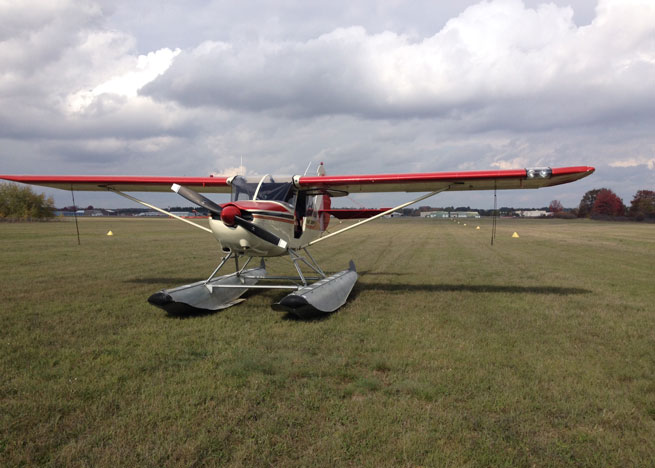A half-ton Dodge truck lines up on the centerline. As the driver adds power, the pilot in a floatplane trailered behind him adds power, too. Quickly accelerating to takeoff speed, the airplane lifts off, banks left, and departs: just another floatplane launch by Joe Sprague of Cadillac Aircraft Services in Cadillac, Mich.
“It draws a lot of attention,” Sprague said, explaining that pilots often bring family members or friends to see them take off behind the pickup truck. “Believe it or not, it’s not a very hard thing to do.”
Floatplane pilots sometimes land on grass at the end of the season when they want to hangar the aircraft for the winter or swap out straight floats for wheels. Maintenance shops at airports near lakes or other bodies of water have no trouble later sending customers on their way; but Cadillac Aircraft Services, based at Wexford County Airport, has no such advantage. Sprague said that many years ago, he and his former boss would have to wake up at 5 a.m. and get a police escort to haul departing seaplanes down to the lake. Then they had the idea of launching from a trailer.
First they tried a free-standing trailer that would stop itself after takeoff, but the airplanes lacked directional control for the start of the takeoff roll. (“That was a bad thing,” Sprague said.) Then they tried a trailer with a long tongue hauled by a truck, but the design still wasn’t quite right. The successful iteration—a modified snowmobile trailer with a 10-foot-long extension to separate it from the vehicle ahead of it for safety—has been launching floatplanes for about 15 years, Sprague estimated. Now about a dozen pilots a year launch from the airport, Sprague said.

AOPA member Harmon Pierce made his first launch from the trailer recently, and like many pilots, brought some friends to watch, with AOPA member Robert Ericson photographing and filming the launch. Pierce said he takes the airplane to Sprague because of his expertise in Aeronca Sedans like his; when he asked the A&P/IA mechanic how he would take off again, “He said, ‘Oh, you take off a trailer. It’s a nonevent.’”
Sprague said he usually recommends that pilots have someone else perform their first takeoff from the trailer; Pierce had a pilot with launch experience take off in 2013 while he observed, and in 2014 he was ready for his own launch. He landed on Wexford County’s grass runway in the fall on straight floats, stored the Sedan in a hangar for the winter, and got his annual and a paint touch-up from Sprague early in the spring.
The day of the launch, Pierce said, they talked about what to do before heading out to the runway. Sprague uses a hoist in the shop to lower floatplanes onto the trailer and said he has procedures written up for pilots to follow for the unusual takeoff. He tells pilots they’ll check for traffic, do their run-up, and wait for a thumbs-up. Sprague gives the truck full throttle, and just like a normal takeoff, they’ll give the airplane full throttle. He tells them to keep the stick or yoke full forward until they’re ready to take off, which he said should be about 10 knots over the speed they’re normally comfortable flying. Then, they pull back slightly on the yoke and take off, staying to the side of the pickup truck.

Other precautions include looking for calm conditions or winds down the runway, and Sprague said that he’ll suggest newly minted seaplane pilots go somewhere else. But for the pilots he briefs on trailer takeoffs, he said he emphasizes that it will be a lot like a normal takeoff.
“Don’t overthink,” he said he tells them. “Don’t make it a bigger deal than what it is. … Just follow these simple rules I have written down here.”
Before he knew it, Pierce was at 70 mph. He lifted off, banked left, and straightened out to parallel the runway. Sprague said many pilots are surprised at how quickly they lift off. The straight-float-equipped Sedan left the runway environment to return to its natural habitat of water.
“For me, it was something really different,” Pierce said.





